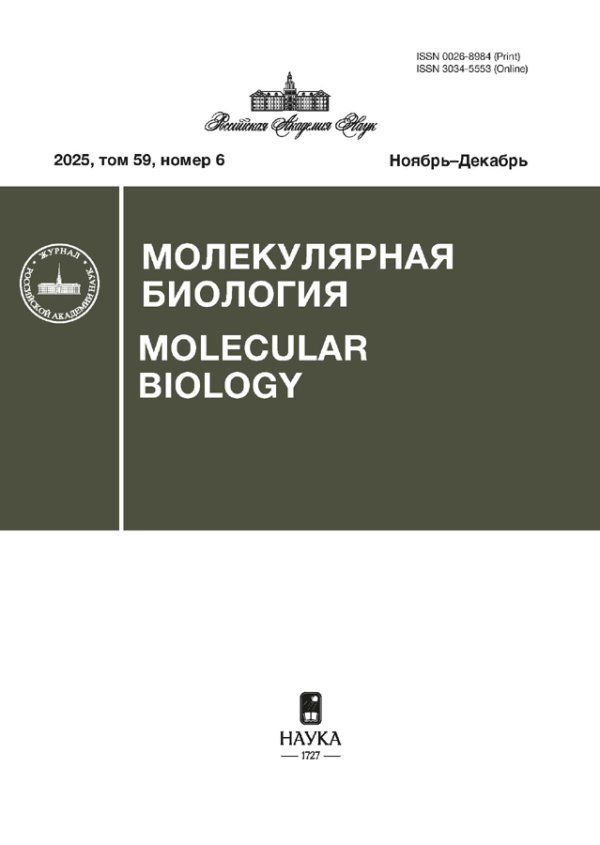Окисление порфирином ZnP1 G4-структур в последовательностях промоторов генов MYC и TERT
- Авторы: Чащина Г.В.1, Калюжный Д.Н.1
-
Учреждения:
- Институт молекулярной биологии им. В.А. Энгельгардта Российской академии наук
- Выпуск: Том 57, № 3 (2023)
- Страницы: 528-536
- Раздел: СТРУКТУРНО-ФУНКЦИОНАЛЬНЫЙ АНАЛИЗ БИОПОЛИМЕРОВ И ИХ КОМПЛЕКСОВ
- URL: https://journals.rcsi.science/0026-8984/article/view/138640
- DOI: https://doi.org/10.31857/S0026898423030035
- EDN: https://elibrary.ru/CGYDDB
- ID: 138640
Цитировать
Полный текст
Аннотация
Формирование G4-структур в двойной спирали ДНК конкурирует с комплементарной нитью. Локальное окружение в ДНК может изменять равновесные G-квадруплексы, изучаемые на однонитевых моделях. Для обнаружения квадруплексов в промоторных областях генома необходимы методы их локализации в составе протяженных ДНК природной последовательности. Порфириновое производное ZnP1 избирательно связывается и приводит к фотоиндуцируемому окислению гуанина в G-квадруплексах в модельных системах с одноцепочечной и двухцепочечной ДНК. На примере нативной последовательности промоторных участков онкогенов MYC и TERT нами показано окислительное действие ZnP1 в областях, потенциально способных формировать G4‑структуры. Установлены и отнесены к нуклеотидной последовательности однонитевые разрывы в G-богатой нити двойной спирали, вызванные окислением гуанина под действием ZnP1 и последующим расщеплением цепи ДНК Fpg гликозилазой. Обнаруженные сайты разрывов соответствовали последовательностям, потенциально способным формировать G‑квадруплексы. Таким образом, продемонстрирована возможность использования порфирина ZnP1 для идентификации и локализации G‑квадруплексов в составе протяженных участков генома. Получены новые данные о возможности сворачивания G4-структур в присутствии комплементарной нити в контексте двойной спирали ДНК природной последовательности.
Ключевые слова
Об авторах
Г. В. Чащина
Институт молекулярной биологии им. В.А. Энгельгардта Российской академии наук
Email: uzhny@mail.ru
Россия, 119991, Москва
Д. Н. Калюжный
Институт молекулярной биологии им. В.А. Энгельгардта Российской академии наук
Автор, ответственный за переписку.
Email: uzhny@mail.ru
Россия, 119991, Москва
Список литературы
- Besnard E., Babled A., Lapasset L., Milhavet O., Parrinello H., Dantec C., Marin J.M., Lemaitre J.M. (2012) Unraveling cell type-specific and reprogrammable human replication origin signatures associated with G-quadruplex consensus motifs. Nat. Struct. Mol. Biol. 19, 837‒844.
- Siddiqui-Jain A., Grand C.L., Bearss D.J., Hurley L.H. (2002) Direct evidence for a G-quadruplex in a promoter region and its targeting with a small molecule to repress c-MYC transcription. Proc. Natl. Acad. Sci. USA. 99, 11593‒11598.
- Spiegel J., Adhikari S., Balasubramanian S. (2020) The structure and function of DNA G-quadruplexes. Trends Chem. 2, 123‒136.
- Marsico G., Chambers V.S., Sahakyan A.B., McCauley P., Boutell J.M., Antonio M.D., Balasubramanian S. (2019) Whole genome experimental maps of DNA G-quadruplexes in multiple species. Nucleic Acids Res. 47, 3862‒3874.
- Chambers V.S., Marsico G., Boutell J.M., Di Antonio M., Smith G.P., Balasubramanian S. (2015) High-throughput sequencing of DNA G-quadruplex structures in the human genome. Nat. Biotechnol. 33, 877‒881.
- Miskiewicz J., Sarzynska J., Szachniuk M. (2021) How bioinformatics resources work with G4 RNAs. Brief. Bioinformatics. 22, bbaa201.
- Grün J.T., Schwalbe H. (2022) Folding dynamics of polymorphic G-quadruplex structures. Biopolymers. 113, e23477.
- Sun D., Hurley L.H. (2010) Biochemical techniques for the characterization of G-quadruplex structures: EMSA, DMS footprinting, and DNA polymerase stop assay. Methods Mol. Biol. 608, 65‒79.
- Guo J.U., Bartel D.P. (2016) RNA G-quadruplexes are globally unfolded in eukaryotic cells and depleted in bacteria. Science. 353(6306), aaf5371.
- Beniaminov A.D., Novikov R.A., Mamaeva O.K., Mitkevich V.A., Smirnov I.P., Livshits M.A., Shchyolkina A.K., Kaluzhny D.N. (2016) Light-induced oxidation of the telomeric G4 DNA in complex with Zn(II) tetracarboxymethyl porphyrin. Nucleic Acids Res. 44, 10031‒10041.
- Chashchina G.V., Beniaminov A.D., Kaluzhny D.N. (2019) Stable G-quadruplex structures of oncogene promoters induce potassium-dependent stops of thermostable DNA polymerase. Biochemistry (Moscow). 84, 562‒569.
- Kovaleva O.A., Tsvetkov V.B., Mamaeva O.K., Ol’shevskaya V.A., Makarenkov A.V., Dezhenkova L.G., Semeikin A.S., Borisova O.F., Shtil A.A., Shchyolkina A.K., Kaluzhny D.N. (2014) Preferential DNA photocleavage potency of Zn(II) over Ni(II) derivatives of carboxymethyl tetracationic porphyrin: the role of the mode of binding to DNA. Eur. Biophys. J. 43, 545‒554.
- Beniaminov A., Chashchina G., Shchyolkina A., Kaluzhny D. (2021) Oxidative probing of the G4 DNA structure induced in double-stranded DNA by molecular crowding or pyridostatin. Biochimie. 191, 33‒36.
- Beniaminov A., Shchyolkina A., Kaluzhny D. (2019) Conformational features of intramolecular G4-DNA constrained by single-nucleotide loops. Biochimie. 160, 122‒128.
- Chaires J.B., Trent J.O., Gray R.D., Dean W.L., Buscaglia R., Thomas S.D., Miller D.M. (2014) An improved model for the hTERT promoter quadruplex. PloS One. 9, e115580.
- Monsen R.C., DeLeeuw L., Dean W.L., Gray R.D., Sabo T.M., Chakravarthy S., Chaires J.B., Trent J.O. (2020) The hTERT core promoter forms three parallel G-quadruplexes. Nucleic Acids Res. 48, 5720‒5734.
- Lim K.W., Lacroix L., Yue D.J.E., Lim J.K.C., Lim J.M.W., Phan A.T. (2010) Coexistence of two distinct G-quadruplex conformations in the hTERT promoter. J. Am. Chem. Soc. 132, 12331‒12342.
- Ambrus A., Chen D., Dai J., Jones R.A., Yang D. (2005) Solution structure of the biologically relevant G-quadruplex element in the human c-MYC promoter. Implications for G-quadruplex stabilization. Biochemistry. 44, 2048‒2058.
- Phan A.T., Modi Y.S., Patel D.J. (2004) Propeller-type parallel-stranded G-quadruplexes in the human c-myc promoter. J. Am. Chem.Soc. 126, 8710‒8716.
- Phan A.T., Kuryavyi V., Gaw H.Y., Patel D.J. (2005) Small-molecule interaction with a five-guanine-tract G-quadruplex structure from the human MYC promoter. Nat. Chem. Biol. 1, 167‒173.
- Arutyunyan A.F., Tevonyan L.L., Beniaminov A.D., Yegorov Y.E., Kaluzhny D.N. (2021) The phototoxic effect of water-soluble porphyrins on human clear cell renal cell carcinoma line Caki-1. Biophysics. 66, 273‒277.
- Miyoshi D., Karimata H., Sugimoto N. (2006) Hydration regulates thermodynamics of G-quadruplex formation under molecular crowding conditions. J. Am. Chem. Soc. 128, 7957‒7963.
- Zheng K.W., Chen Z., Hao Y.H., Tan Z. (2010) Molecular crowding creates an essential environment for the formation of stable G-quadruplexes in long double-stranded DNA. Nucleic Acids Res. 38, 327‒338.
- Liu L.-Y., Ma T.-Z., Zeng Y.-L., Liu W., Mao Z.-W. (2022) Structural basis of pyridostatin and its derivatives specifically binding to G-quadruplexes. J. Am. Chem. Soc. 144, 11878‒11887.
- Severov V., Tsvetkov V., Barinov N., Babenko V., Klinov D., Pozmogova G. (2022) Spontaneous DNA synapsis by forming noncanonical intermolecular structures. Polymers. 14, 2118.
- Hasanau T., Pisarev E., Kisil O., Nonoguchi N., Le Calvez-Kelm F., Zvereva M. (2022) Detection of TERT promoter mutations as a prognostic biomarker in gliomas: methodology, prospects, and advances. Biomedicines. 10, 728.
Дополнительные файлы















